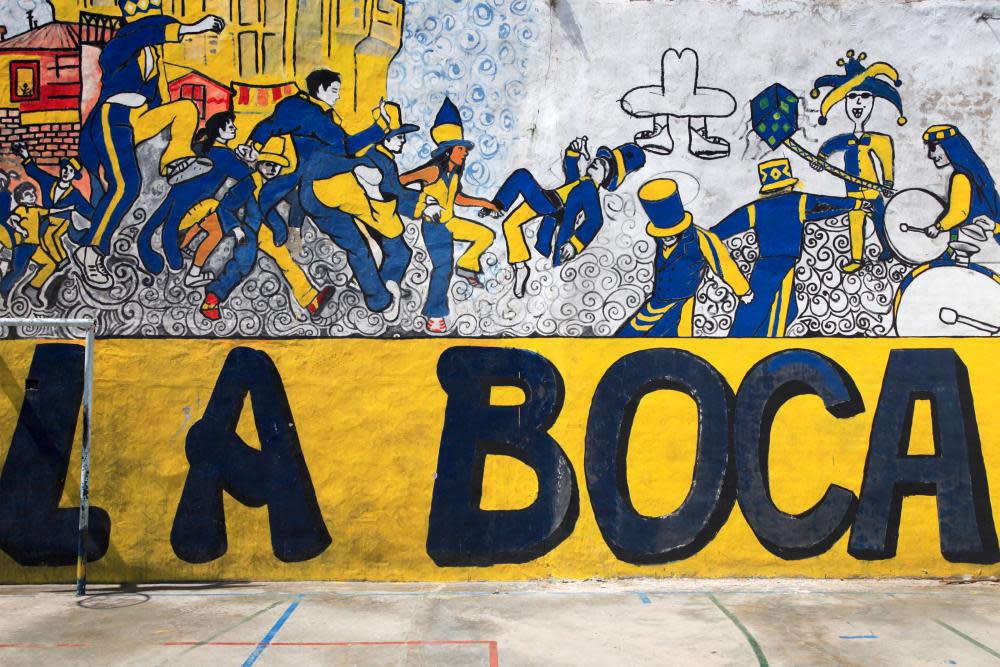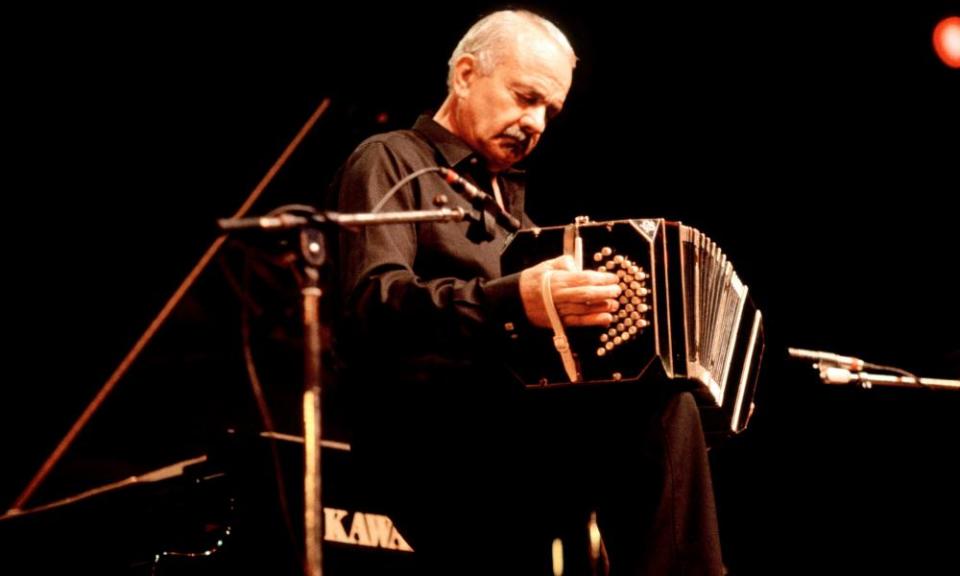Tour of tangopolis: a dance through the rhythms of Buenos Aires

Listen to Chris Moss’s Piazzolla 100 selection on Spotify
On a central reservation in Puerto Madero, Buenos Aires’ youngest and least atmospheric neighbourhood, stands a strange-looking monument. It’s a twisted, abstract sculpture, in steel, that looks at first glance like the cooling fins from a motorbike engine. It is, in fact, an unfurled bandoneón (button accordion), the fiendishly difficult instrument of German origin that produces the unmistakeable sound of tango: a pained and plangent breath from a broken heart.

The composer, bandleader and musician who made the bandoneón globally famous was Astor Piazzolla, whose centennial in 2021 will be celebrated – or, at least, remembered – by players, dancers, singers and songwriters the world over. “His fingers move about that instrument as though they were snakes,” said jazz legend Gerry Mulligan. For his part, Piazzolla said the button accordion had “a velvet sound, a religious sound”. He was the high priest of that religion.
On 5 March, Buenos Aires’ venerable Colón opera house reopened after a year-long closure with a two-week Piazzolla programme. Here in the UK, scheduled tributes, such as a “¡Viva Piazzolla!” night at the Liverpool Philharmonic, have been either deferred or cancelled. There are, though, virtual events honouring the centennial, including monthly gigs beamed from Boedo in Buenos Aires, lectures and dance classes in Philadelphia and a free Piazzolla “cyber jazz” show from Nottingham .
I’ll be toasting Piazzolla’s memory with a glass of Argentine vino and spinning a few scratchy shellacs on my ancient gramophone. All right, I exaggerate: tango brings out my inner melancholic. But I will take out some vinyls and CDs, not just Piazzolla but his precursors and heirs, and play the songs that changed my perception of Buenos Aires. Unable to be in the city right now – I lived there from 1991 to 2001 and visited at least once a year until 2019 – I rely on tango to transport me there.
Piazzolla’s one-time collaborator, the poet Horacio Ferrer, called Buenos Aires a “tangopolis”. He meant that, from the radio soundtrack during a taxi ride to the psychodramas of everyday life to the way people walk and talk, tango left an indelible mark on the city and its people. Does this mean that the tango city can be seen by the virtual visitor? Well, yes, but you have to squint somewhat to penetrate beyond the facades of the modern metropolis and – I’d suggest – plug in a song or two on your earbuds to help you visualise the ghosts of the tango era.

It’s often remarked, somewhat sensationally, that tango was born in the bordello. Certainly there are songs – such as Celedonio Flores’s Margot – that namecheck this milieu, and orchestras were used in brothel waiting rooms to keep clients entertained. But tango experts agree that the primal origins were in the arrabales – the run-down outskirts along the river and the working-class districts of the fast-growing city of the 1890s. The place to get a sense of this is La Boca, which, away from the pastel-hued tourist honeypot of Caminito (named after a 1926 tango by Juan de Diós Filiberto), has retained a shabby, edgy quality. Many tangos are set in the district, which as a port was a melting pot for immigrants from Europe as well as black Argentinians. Ángel Villoldo, an Argentinian of African heritage who has been dubbed the “father of tango”, performed bright, sometimes bawdy songs in La Boca bar rooms in the first decade of the 20th century.
Tango skipped across the ocean around this time, enjoyed a boom in Paris, and then arrived back in BA. The Argentinian middle classes promptly fell in love with it. Venues such as Cafe Hansen and the Armenonville cabaret sprang up around Buenos Aires’ well-to-do barrios and, in 1912, wealthy bon vivant Baron Antonio de Marchi organised a showcase for a patrician audience at the Palais de Glace. This ushered in an era of great orchestras led by the likes of Osvaldo Fresedo, Juan Carlos Cobián and Julio de Caro. It’s also the era of grand cafes: surviving landmarks like the Cafe Tortoni have kept up their links with tango through intimate concerts and milongas (dance nights); and many of the so-called cafés notables (listed establishments) have photographs of tango greats on their walls; others are named after songs or artists.

Tango canción (tango songs with words) dates from this period. Its foremost practitioner, Carlos Gardel, wrote music to words by poet-lyricists such as Alfredo Le Pera and Pascual Contursi. Hit songs – Volver, Mi Buenos Aires Querido, Por Una Cabeza – are alternative national anthems for many porteños. There’s a statue and street art celebrating Gardel in Abasto, where he spent most of his days when not on tour. The best monument to him is above his tomb at the Chacarita cemetery, while Recoleta’s necropolis has the posh marble mausoleums, Chacarita’s houses tango legends. Gardel fans sometimes drop by to leave flowers and to slot a lit cigarette between his statue’s stone fingers. Gardel’s songs about local bars, friendship, barrio life, betting and drinking played a major role in tango-ifying the city, showing any theme could be set to music – sad, sprightly or otherwise.
A little later, tango went through an evolutionary period. Charismatic frontmen like Aníbal Troilo – another bandoneón superstar – and pianist Osvaldo Pugliese added layers of musical complexity, while women singers such as cross-dressing Azucena Maizani, glamorous Ada Falcón, dirt-poor Rosita Quiroga and outspoken Peronist Nelly Omar – later blacklisted by the military government – challenged male hegemonies. In Buenos Aires, even the street names are sexist – but in the 1990s when Puerto Madero was made the city’s 47th barrio, it was decided to honour women in street names; Maizani and Quiroga have their own calles now.
By the second world war, the golden age of tango was pretty much over. In 1944, Enrique Cadícamo penned a song about the Palais de Glace that ripples with nostalgic longing.
But Piazzolla, who had played in Troilo’s band, had other ideas. He set out creating a “nuevo tango” that enlivened the rhythms of tango with jazz and neo-classical touches. He was not short on sentiment – his Adiós Nonino (Goodbye Grandaddy) – is unashamedly slushy. But he introduced experimentation, chromatic harmonies, atonality, dissonance and a contemporary pace and punch. Inspired by Vivaldi he wrote a four-seasons cycle for Buenos Aires. He composed a “little opera” called María de Buenos Aires. He wrote symphonic works, used electric guitar and collaborated with vibraphone players and famous authors like Borges. Initially, the squares who preferred their tango in stockings and dandruffed suits rejected his ideas as pretentious and even traitorous; but in the end they were won over and, in June 1983, he had his own gala night at the Colón – described by local daily La Nación as “Piazzolla’s apotheosis.”
If Gardel’s songs evoke Buenos Aires in a literal manner, Piazzolla’s compositions conjure a more fantasy-laden city. Sublime works like Milonga del Angel, Escualo and Vuelvo al Sur contain hints of ideas about the city – the angel statues in the cemeteries, the dancers in the plazas, the cobbled streets of the southside – but never crudely or clumsily. Once, in San Telmo, I saw a young trio hammering out Libertango – the most famous of all Piazzolla’s songs, thanks to Grace Jones’s 1981 cover version – and the music made for an absolutely perfect soundtrack of the barrio as we see it today – past and present colliding, tangueros mixing with rock kids and metal fans, and tango a cultural artefact rather than a real, lived experience for most people.
When I get over to Buenos Aires, I’ll see a tango band at Centro Cultural Torquato Tasso, do some tango-themed walks and go shopping for records in the markets and disquerías. I’ll pay my belated respects to Piazzolla. There’s a bust of him in Recoleta and a statue in the Atlantic seaside resort of Mar del Plata, his birthplace; but the steel bandoneón remains the most fitting homage. He was a passionate and argumentative artist who enjoyed upsetting the establishment and took tango kicking and screaming out of the ballroom and in to the concert hall. He was a sublime writer and arranger of songs, suites, concerti and film music. But he was most fully himself when he was live on stage, at the front of a quintet or octet, pulling out the ends of his bandoneón as his brow unwrinkled and he let the angels, and devils, sing. He demonstrated, through his virtuosity, that the humble accordion possesses the emotional expressiveness of a violin or piano. He also proved you don’t need to be a good dancer – or a dancer at all – to love, and live, tango. As someone who prefers his Latin rhythms sitting down, I’m eternally indebted to Astor Piazzolla.
Chris Moss is a travel and music writer. He compiled the Rough Guides to Astor Piazzolla and Tango Nuevo, and wrote about Piazzolla’s centennial for the current issue of Songlines magazine


